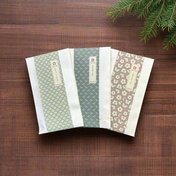Do you know what this is?

This is called Kombu, a very important ingredient in the Japanese diet.
What's Kombu?
Kombu (or konbu, as it is spelled in Japan) is a large algae belonging to the brown algae(Phaeophyceae) in the order Laminariales. It lives in cool and relatively shallow waters close to the shore. There are 35 different genera around the world, and their distribution is according to climate, current and conditions. 14 genera of Kombu are grown in the north part of Japan such as Hokkaido, Aomori and Iwate , and more than 90% of Kombu is harvested from Hokkaido.

Rishiri kombu, in the Rishiri island, Hokkaido
Kombu in the Japanese History
Kombu is thought to be eaten for more than 3000 years. The earliest written reference comes from the Shoku Nihongi 続日本記 ,the 2nd Japanese Chronicle compiled in 797 that the chief of Ezo (Hokkaido) area offered Kombu to the Imperial Court. The Imperial Court used it for celebrations and religious ceremonies. It was also given to temples, and used for Buddhist cuisine. Kombu was a widely-used ingredient throughout the country during the Edo Period (1603-1867).
Kombu is eaten at celebratory occasions to symbolize happiness. This is because the sound 'kombu' is similar to the word 'yorokobu (喜ぶ)' which means 'to rejoice' in Japanese.

Can you see the two brown things stripped with something yellowish brown in the front case? It's called Kobumaki or Kombumaki, fish eggs wrapped in Kombu. This box is called Osechi Ryori, dishes for a New Year.
Nutrition
Kombu is thought to be a very important ingredient for people's diet in the prehistoric period, particularly their sodium intake. Kombu is also a rich source of minerals such as calcium, iron, magnesium, potassium, and iodine, as well as the trace minerals copper and zinc. Kombu also contains high levels of vitamins and a great source of dietary fiber. Kombu is one of the most alkaline foods, and therefore can balance your body in alkaline which is good for your health.
Kombu's Secret Flavor
Kombu adds a rich flavor to your cooking. It's because Kombu produces Umami flavor.Umami can be described as a pleasant "brothy" or "meaty" taste with a long-lasting coating sensation, and translated as a "pleasant savory taste" or ”fifth taste” that is distinct from the four standard taste sensations of sweet, salty, sour and bitter. It is caused by the interaction of glutamates. Kombu is rich in glutamate and aspartate which are types of amino acids.
As well as the umami flavor, Kombu also gives you some sweetness. Can you see the white powder on it?

You may think it’s mold, but in fact a type of sugar alcohol called mannitol which naturally rises to the surface as it dries.This is the source of the sweetness in Kombu.
How to use Kombu in the Japanese Traditional Cuisine
Kombu is sold in several ways, such as fresh, dried, and pickled. They are cut into pieces, powdered or shredded. Kombu dashi soup stock made from dried Kombu is one of the main broths in Japanese traditional food.

Kombu dashi soup stock
Tsukudani ,kombu simmered in sake (Japanese rice rice),shoyu (soy sauce) and mirin (sweetened Japanese rice wine), is a popular topping for rice.

Tsukudani
You can stir-fry vegetables, make pickles and salad with fresh/dried/pickled kombu. You can make anything with Kombu. We even have Kombu tea !! Kombucha is a popular and healthy drink made by infusing dried and shredded kombu in hot water. There are lots of processed kombu products sold in stores.
Common Kombu Products in Convenience Stores
I'm curious to see if they sell Kombu products in Konbini (Japanese convenience stores).Konbini is a type of one stop shop / newsagent shop that can be found on the corner of almost all city streets.
I went into a store nearby and looked at how many Kombu products they have. I found these ones.

1 Dashi soup stock
2 Tsukudani (see above)
3 Onigiri, rice ball Tsukudani is stuffed inside
4 Shio kombu a type of Tsukudani flavored by salt
5 Kombu ume (Japanese apricot) a type of snack, kombu flavored with ume and salt
There are many foods containing kombu even in a small store.I can imagine someone grabs a rice ball for his/her lunch, someone buys a snack for his/her break, someone takes something home, and use them for cooking, etc. People enjoy kombu in their lives. Kombu remains an important ingredient for the Japanese diet as it has always been.

Freshly harvested Kombu
Currently, many people in the world outside Japan have been talking about Kombu(kelp) with the view of environmental conservation, and thinking of it as future food. Maybe you would like to incorporate Kombu into your life.
Recipe with Kombu
Recipe for Asazuke (浅漬け, Light-Pickled) of Small Red Radishes and Celery

Today's Recommendations
Oguraya: Natural Kelp Seaweed, Rishiri Konbu

Dried Kombu Harvested in the coasts of Rishiri island, Hokkaido, can produce a clear and flavorful broth.
Mannen: Kombucha Kelp Soup Tea Powder こんぶ茶
We drink the savory, salty flavor as a tea. You can also add the powder in your cuisine for broth.
Ohsawa Japan: Concentrated Kombu Dashi (Kelp Seaweed Broth, 12 x 5g)
This Dashi broth powder made from Hidaka Kombu (Hidaka, Hokkaido), natural table salt, rice sugar, yeast extract, is marketed to vegans in Japan, using natural flavor.
We also have many other Kombu products in our shop, so please have a look.


